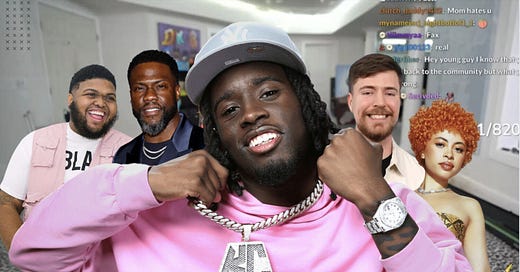Gaming isn’t just a subculture anymore. It’s THE culture
Kai Cenat, Coca-Cola and the future of marketing
The notification popped up on millions of phones:
"KaiCenat is live."
But this wasn’t just another stream.
This was the night that reshaped how we think about influence, authenticity (I know, we hate the word), and staying true to yourself.
It was the Mafiathon, a livestream that took Kai Cenat from just a popular Twitch streamer to a cultural force that changed the influencer game, gaining 727,700 subscribers by the 30th day and a total of 50 million viewers.
Lizzo.
Kevin Hart.
GloRilla.
Some of the biggest names in pop culture joined him online.
I don’t believe celebrities just show up on his stream because it’s profitable; they come because they trust him to let them be their true selves.
And his fans see that.
They feel it.
BUT, that’s not what made it good.
Six months earlier, Kai had made what many considered an insane decision.
A $60 million offer from Kick sat on the table, the kind of money that could change not just a life, but generations.
Surely, he’d take it, right?
Everyone takes the money.
That’s how the game works.
Wrong.
He chose to stay with Twitch.
It was a decision that had even industry veterans shaking their heads.
But that choice was about more than just a platform.
It was a testament to the value of his brand: staying true to his audience and his integrity, rather than chasing the big bucks.
“It wasn't right. I couldn't join Kick at the time because I realized that not all money is good money. Some money you could take and deals you could sign that would jeopardize everything you built up.” - Kai Cenat
And now, brands don’t pitch to Kai, they apply.
Every collaboration is a privilege.
That night was the perfect example of this new intersection of entertainment, influence, and digital culture.
For those who aren’t too familiar with how gaming works, here’s the deal: Twitch subscribers usually pay $4.99 a month for things like ad-free viewing and access to exclusive subscriber-only chats with their favourite streamers. Normally, Twitch takes a 50% cut of that revenue, but for its top creators, that drops to around 30-40%.
Cenat’s team hasn’t shared exactly how much he made from his stream, but based on his Tier 1 subscriptions, CNBC estimated he may have pulled in around $3.6 million in revenue, before Twitch took its cut.
Crazy, right?
And if you thought turning down the $60 million deal was the only big move?
Cenat also announced he’ll be donating 20% of the proceeds from the stream towards building a school in Nigeria, after visiting a settlement in Makoko.
Again, community.
What we can learn from Kai, and others, is that being yourself is the new currency of influence.
When you’re real, people,whether they’re celebrities or fans,want to be a part of what you’re building.
Basically, for brands, Kai represents a new era of influence, where staying true to oneself isn’t just good ethics, it’s good business.
Gaming culture’s influence on mainstream marketing
Gaming culture has shifted the way brands market themselves.
They aren’t just tapping into gaming culture; they’re actively investing in it.
Influencer marketing in gaming reached over $4.4 billion in 2022, up from $2.5 billion in 2021. By the end of Q2 2024, over 700 brands had established a presence in virtual worlds, with more than 1,200 activations across platforms like Roblox, Fortnite, and Minecraft.
As gaming culture continues to dominate, brands are looking for ways to incorporate gamification into their marketing without turning off non-gamers.
It’s all about using simplified gaming elements that are accessible and engaging.
It needs to make sense.
And it needs to not be boring.
You could think of decision-making challenges, where every choice impacts the journey or add in some fun with AR or VR to create an immersive experience that captures the excitement of gaming, without excluding the casual viewer.
I digress, but brands like Coca-Cola are already killing it.
With personalised bottles, in the past they’ve created a gamified element that encouraged people to share and engage, perfectly blending real-life and gaming-inspired marketing.
Gamings influence on marketing will only grow:
The numbers don’t lie: The global gaming market is expected to hit $503.14 billion in annual revenue by 2025, up from $396 billion in 2023. In-game advertising revenue alone is set to skyrocket to $137 billion by 2027, nearly doubling from $70 billion in 2022.
This isn’t just a trend, it’s the future of engagement.
For brands, understanding gaming culture is no longer optional; it’s important to staying relevant in a digital-first world.
And it’s not just about the games.
Virtual characters and digital influencers, like the Snoop Dogg avatar in Notion, are pushing boundaries and redefining how audiences interact with content.
So, whether you’re a creator, a brand, or just someone paying attention, one thing is clear: gaming isn’t just a subculture anymore. It’s the culture.
Until next time, keep listening, keep learning, and keep evolving.
And make sure you digress often. Curiosity is key to winning in this game.
Charlotte
If you missed last week’s newsletter:







